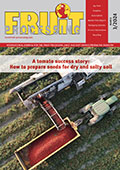Brazil: Processing plants purchasing oranges in the spot market
One of the large-sized processing plants from São Paulo State started purchasing oranges in the spot market in the first fortnight of May – early varieties from the 2019/20 crop as well as fruits out of the ideal period from the 2018/19 season.

One of the large-sized processing plants from São Paulo State started purchasing oranges in the spot market in the first fortnight of May – early varieties from the 2019/20 crop as well as fruits out of the ideal period from the 2018/19 season. Two plants of this large-sized processing plant were crushing oranges in that period, one in Araraquara and the other in Colina.
Bidding prices were around 18 BRL per box, harvested and delivered at the processing plant, lower than that observed until December/18 for mid and long-term contracts, which ranged from 20 to 22 BRL per box – with the possibility of a participation additional in the international juice market. At smaller-sized processing plants, in turn, quotes ranged from 14 to 20 BRL per box in the spot market – depending on both the processing plant and the quality desired.
For mid and long-term contracts, the purchases of oranges from the new crop have been occasional this year, with no fixed prices and deals closed between some of the large-sized processors only.
The citrus farmers consulted by Cepea are concerned about the effects of the higher production expected for the citrus belt (São Paulo and Triângulo Mineiro) in 2019/20 on orange prices.
Higher supply estimates are based on the good development of orange orchards in all Brazilian regions, favorable weather in the second semester of 2018 (with mild heat and well-distributed rains) and the resume of investments. Still, greening should constrain yield at many orchards in SP.
Although higher productivity in 2019/20 may lower the unit cost of production, the new bidding prices are considered low compared to expenses, which may constrain the revenue paid to the growers who will depend on sales in the spot market. Concerning fruit volume, most oranges have already been traded, through contracts – either previously closed or closed in late 2018. However, a high number of farmers, probably smaller-sized ones, may have been waiting for prices to be fixed this year in order to sell their fruits.
THE MARKET IN MAY – Oranges quotes dropped in the first fortnight of May, pressed down by both higher supply and low purchases from processing plants. Between May 2 and 15, pear orange quotes averaged 23.03 BRL per 40.8-kilo box, on tree, 34.5 % down compared to that in the first fortnight of April.
TAHITI LIME – The demand for tahiti lime was low in the first half of May, while supply continued high in the field of São Paulo State – due to the delay in fruit maturation in the first months of 2019. Between May 2 and 15, tahiti lime was traded for 17.20 BRL per 27-kilo box, harvested, 26.8 % down compared to that in the first fortnight of April.
EXPORTS – In the international market, the demand for tahiti lime was firm, due to the higher quality of the fruits available. However, this year, the Brazilian exports of tahiti lime have been lower than in 2018. In April/19, shipments totaled 10.6 thousand tons, according to Secex, 9 % down compared to that in April/18. Between January and April 2019, exports were 20 % lower than in the same period last year.









